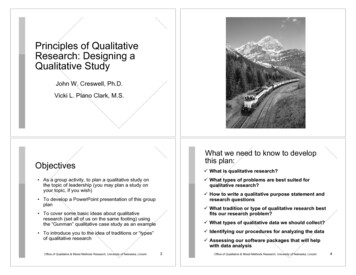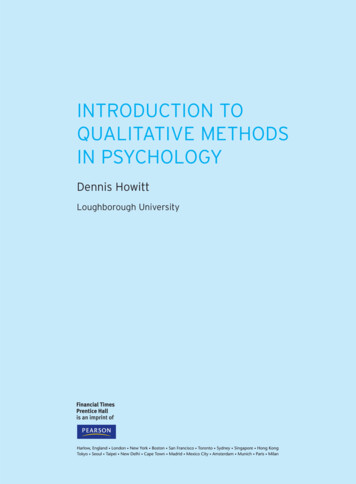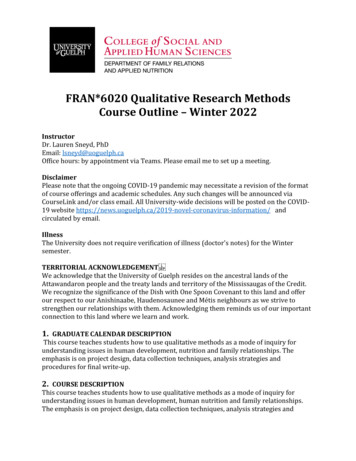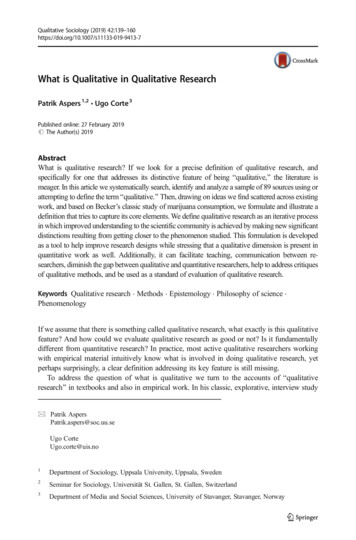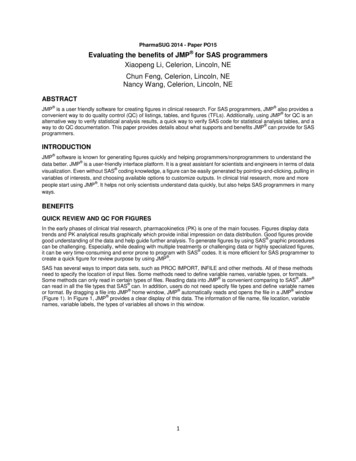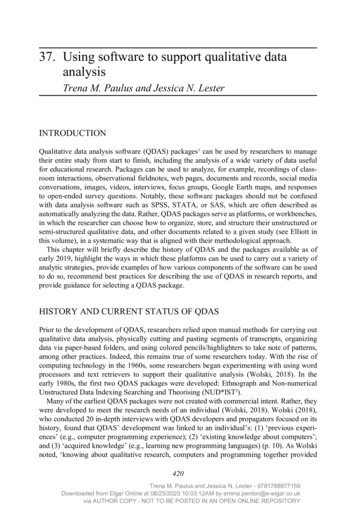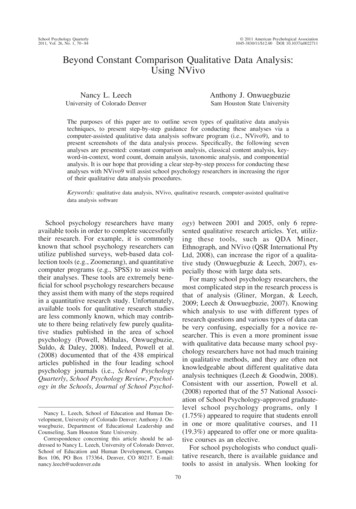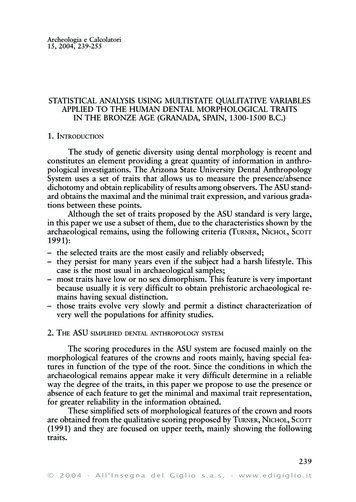
Transcription
Archeologia e Calcolatori15, 2004, 239-255Statistical analysis using multistate qualitative variablesSTATISTICAL ANALYSIS USING MULTISTATE QUALITATIVE VARIABLESAPPLIED TO THE HUMAN DENTAL MORPHOLOGICAL TRAITSIN THE BRONZE AGE (GRANADA, SPAIN, 1300-1500 B.C.)1. INTRODUCTIONThe study of genetic diversity using dental morphology is recent andconstitutes an element providing a great quantity of information in anthropological investigations. The Arizona State University Dental AnthropologySystem uses a set of traits that allows us to measure the presence/absencedichotomy and obtain replicability of results among observers. The ASU standard obtains the maximal and the minimal trait expression, and various gradations between these points.Although the set of traits proposed by the ASU standard is very large,in this paper we use a subset of them, due to the characteristics shown by thearchaeological remains, using the following criteria (TURNER, NICHOL, SCOTT1991):– the selected traits are the most easily and reliably observed;– they persist for many years even if the subject had a harsh lifestyle. Thiscase is the most usual in archaeological samples;– most traits have low or no sex dimorphism. This feature is very importantbecause usually it is very difficult to obtain prehistoric archaeological remains having sexual distinction.– those traits evolve very slowly and permit a distinct characterization ofvery well the populations for affinity studies.2. THE ASUSIMPLIFIED DENTAL ANTHROPOLOGY SYSTEMThe scoring procedures in the ASU system are focused mainly on themorphological features of the crowns and roots mainly, having special features in function of the type of the root. Since the conditions in which thearchaeological remains appear make it very difficult determine in a reliableway the degree of the traits, in this paper we propose to use the presence orabsence of each feature to get the minimal and maximal trait representation,for greater reliability in the information obtained.These simplified sets of morphological features of the crown and rootsare obtained from the qualitative scoring proposed by TURNER, NICHOL, SCOTT(1991) and they are focused on upper teeth, mainly showing the followingtraits.239 2004 - All’Insegna del Giglio s.a.s. - www.edigiglio.it
J.A. Esquivel, I. al Oumaoui, S. Jiménez-Brobeil2.1 Crown characters of incisors and caninesThe traits used are winging with reference to the upper central incisors(ENOKI, DAHLBERG 1958; TURNER 1970); Labial Convexity relative to upperincisors (NICHOL, TURNER, DAHLBERG 1984; SCOTT, TURNER 1997); Shovelingis relative to upper incisors, canine and lower incisors (HARDLICKA 1920;DAHLBERG 1956; SCOTT, TURNER 1997); Double-Shoveling occurs in upperincisors, canine and lower incisors (DAHLBERG 1956); the Interruption Grooveappears in upper incisors (SCOTT, TURNER 1997); the Tuberculum Dentalefeature is present in upper incisors and canines (NICHOL, TURNER 1986); theCanine Mesial Ridge or Bushman canine is located in upper and lower canines (MORRIS 1975; SCOTT, TURNER 1997); Canine Distal Accessory Ridgeappears in upper and lower canines (MORRIS 1975; SCOTT, TURNER 1997); thePeg-Shaped character occurs in the upper lateral incisors (SCOTT, TURNER 1997);Congenital Absence character appears in the upper lateral and lower centralincisors (MONTAGUE 1940; SCOTT, TURNER 1997); the Canine Root Number ispresent in lower canines (SCOTT, TURNER 1997).2.2 Crown characters of premolarsThe traits studied include the Double-Shoveling located in the first premolar (DAHLBERG 1956); the Premolar Mesial and Distal Accessory Cusps occursin the upper premolars (TURNER 1967); Tricusped Premolars is a very rare traitlocated in the upper premolars (SCOTT, TURNER 1997); the Distosagittal Ridgeor “Uto-Aztecan Premolar” appears in the first upper premolar (MORRIS et al.1978); Enamel Extensions are present in the upper premolars (PEDERSEN 1949);Premolar Root Number is measured in the upper premolar (SCOTT, TURNER1997); the presence of Odontome occurs in the upper and lower premolars(PEDERSEN 1949; ALEXANDARSEN 1970; SCOTT, TURNER 1997); Congenital Absence character appears in the upper lateral and lower second premolars(MONTAGUE 1940; SCOTT, TURNER 1997); Tomes’ Root is present in lower firstpremolars (TOMES 1923; SCOTT, TURNER 1997).2.3 Crown characters of molarsThe traits considered are the Metacone and the Hypocone characterslocated in the upper molars (DAHLBERG 1951; TURNER 1979); Cusp 5 orMetaconule trait appears in upper molars (HARRIS 1977); the Carabelli’strait appears in the upper molars (DAHLBERG 1956; SCOTT, TURNER 1997);the Parastyle character is located in upper molars (BOLK 1916; SCOTT, TURNER1997); Enamel Extensions are present in the upper molars (PEDERSEN 1949);the Upper Molar Root Number is measured in the upper molars (SCOTT,TURNER 1997); the Peg-Shaped molar character occurs in the upper thirdmolar (SCOTT, TURNER 1997); Premolar Lingual Cusp Variation is very sen240 2004 - All’Insegna del Giglio s.a.s. - www.edigiglio.it
Statistical analysis using multistate qualitative variablesFig. 1 – The ASU system. Simplified database.sitive to wear and occurs in the lower premolars (PEDERSEN 1949; KRAUS,FURR 1953; SCOTT, TURNER 1997); the Congenital Absence character appears in the upper lateral and lower third molars (MONTAGUE 1940; SCOTT,TURNER 1997); the Anterior Fovea trait is located in the lower first molar(HARDLICKA 1924; SCOTT, TURNER 1997); the Groove Pattern feature appears in the lower molars with three scorings: X, Y and (HELLMAN 1928;JORGENSEN 1955; SCOTT, TURNER 1997); the Cusp Number scores the cuspnumber in the lower molars (GREGORY 1916; SCOTT, TURNER 1997); Deflecting Wrinkle appears in lower first molar (SCOTT, TURNER 1997); Distal Trigonid Crest occurs in the lower molars (HARDLICKA 1924; HANIHARA 1961;SCOTT, TURNER 1997); Protostylid character is located in the lower molars(DAHLBERG 1956; SCOTT, TURNER 1997); Cusp 5, Cusp 6 and Cusp 7 arelocated in lower molars (SCOTT, TURNER 1997); Lower Molar Root Numberis present in lower molars (TURNER 1971; SCOTT, TURNER 1997).This set of morphological features is stored by means of a databasedeveloped in ACCESS database management using a form of data recordingthat includes the set of simplified morphological dental features (Fig. 1).241 2004 - All’Insegna del Giglio s.a.s. - www.edigiglio.it
J.A. Esquivel, I. al Oumaoui, S. Jiménez-BrobeilThis database form developed is easy to use, and includes the list of theteeth (see diagram) and the list of the jaws, and features verification fields toavoid possible mistakes. It also includes other optional information about thearchaeological site: the settlement key (in Spain this codification is composedof two alphabetical characters belonging to the province, two alphabetical characters belonging to the town, and a number (with three digits) correspondingto the settlement in the town, the place-name, the chronology and the UTMcoordinates of the settlement. This information is important for comparingtwo or more different settlements, but it is possible to save each archaeologicalsite data set in an independent file and merge the files later.The information recorded in the database can be exported to another software like EXCEL, SPSS, MATLAB, the interchange format ASCII, and so. Thisdata set file can be analysed by means of standard statistical procedures, MATLABroutines, etc., or can be written using WORD or other software packages.3. THE MMD (MEDIAN MEASURES DIVERGENCE)METHODThe previous method allows us to convert the variables in dicotomizedqualitative variables, and it makes the assumption that there is only a singlegenotype for any specific trait, and that, when asymmetry is present, theantimere exhibiting the greater degree of trait expression is the more accurate indicator of the genotype. The score used is the highest grade of expression observed between the two sides (TURNER, NICHOL, SCOTT 1991). However, the statistical MMD method is established for general qualitativemultistate variables, and not presence/absence variables only.The statistical procedure assumes that the variables are independentvariables with no correlation between them, and each one follows a binomialdistribution because the global population is very large. Then, for each traitthe expectation of the proportion p and the variance of p is:being P the proportion of the trait in the total population (an unbiased estimator of P, that has the least variance and is a sufficient estimator) and N isthe number of individuals in the sample. However, if N is small for a variablethere may be great discrepancies between p y P, and all the proportions donot have equal importance. Therefore, it is essential to transform the proportion p in a new variable with no dependent variance of the population proportion P; this new quantitative variable is obtained using the inverse sinetransformation, measured in radians, by means of the formula (GREWAL 1962):242 2004 - All’Insegna del Giglio s.a.s. - www.edigiglio.it
Statistical analysis using multistate qualitative variablesThis variable has the advantage that the variance is approximately 1/Ninstead 820.7/N (this is the variance obtained using the more usual transfor (BERRY, BERRY 1967; SJØVOLD 1973).mation Θ arcsin p)The test of differences between two populations was established byBERRY (1963) according to:under the hypothesis that there is no genetic difference between the populations compared, the proportions p1 and p2 in two samples must be equalapart from sampling fluctuations. Then, the difference Ø1 - Ø2 is approximated by a normal distribution with variance (1/N1 1/N2), and the statisticis distributed by means of a normal distribution N(0,1). Therefore, the expressionfollows adistribution, and the expressionwill be approximately distributed according to. And it can bedemonstrated (SJØVOLD 1973) that the expectation of X is E(X) 0 and thevariance of X isThe Mean Measure Divergence between the samples 1 and 2 using themean of X extended to all traits is defined by:243 2004 - All’Insegna del Giglio s.a.s. - www.edigiglio.it
J.A. Esquivel, I. al Oumaoui, S. Jiménez-Brobeilbeing:θ1i angular transformation of the proportion p1 of elements in the sample 1for the trait i;θ2i angular transformation of the proportion p2 of elements in the sample 2for the trait i;N1i number of elements in the sample 1 having no missing the trait i;N2i number of elements in the sample 2 having no missing the trait i;V number of traits that can be evaluated in the samples.The variance of MMD is obtained by means of the expression (BERRY,BERRY 1967):The p1i and p2i proportions can take extreme values distorting the angular transformation. In this case the previous values must be replaced by thefollowing values (SJØVOLD 1973):– if the proportions are near 0 we must take– if the proportions are near 1 we must takeThe MMD value is distributed according toandand, but it isusual to use the following rule proposed by BERRY, BERRY, UCKO (1967):ifis bounded for each i, the MMD is asymptotically normally dis-tributed and is significant at the 0.05 probability level when the MMD istwice than its standard deviation (SJØVOLD 1973; SJØVOLD 1977; AL-ABBASY,SARIE 1997; BAILEY 2000).4. THECLUSTER ANALYSIS ALGORITHMCluster analysis constitutes a very important statistical method to detect grouping in a data set, and many techniques are developed to makeclassifications, groups of objects, etc., based on quantitative variables. However, an important part of the archaeological data is defined by means of244 2004 - All’Insegna del Giglio s.a.s. - www.edigiglio.it
Statistical analysis using multistate qualitative variablesqualitative variables with several states, but there are no procedures adaptedfor grouping these data except for presence/absence data (SNEATH, SOKAL 1973;ROMESBURG 1984; KRZANOWSKI 1988).The methods of analysis for qualitative variables usually codify eachstate of each variable as a new presence/absence variable, loosing the linkagebetween the states in the same variable. This problem has been approachedby several scientific theories such as image recognition, string of symbolsrecognition, database management, archaeological pattern recognition of incomplete data, etc. (MICHALSKI, STEPP 1983; BEN-BASSAT, ZAIDENBERG 1984;CHIU, WONG 1986; ESQUIVEL 1988; FUKUNAGA 1991).According to the Shannon theory, in a mathematical communicationmodel the information is determined by a statistic parameter associated with aprobability scheme, and it must indicate a measure related to the uncertaintyaccording to the occurrence of a particular message in a set of messages:We propose that the information carried out by the xik state with experimental probability pik and ni number of states, and the associated entropyto the Xi variable are defined as:The entropy H(Xi) minimizes the influence of the rare cases; butthis influence is very important to study the association between elementsbecause: «the agreement in rare states is less probable that the agreementbetween frequent states and it must be more valued» (SNEATH, SOKAL 1973).The total entropy of the Xi (ESQUIVEL 1988) is accord to the previousideas:The total entropy D(X i) measures the byass or distortion that produces a non regular variable in the space of elements.Being G {A1, A2, . An} the set of elements defined by the set of qualitative multistate variables V {X1, X2, . Xv}, and ni the number of states ofvariable Xi. Each element has linked a mathematical object defined by the npla of measures (DUBOIS, PRADE 1980) m(Ai) {(m1(Ai), m2(Ai), . mv(Ai)},k 1,.,v and i 1,.,n, being mk(Ai) xkj if j is the index of the state of variable Xk that is in Ai. The set of mathematical objects defined by this proce245 2004 - All’Insegna del Giglio s.a.s. - www.edigiglio.it
J.A. Esquivel, I. al Oumaoui, S. Jiménez-Brobeildure is named the “pattern space” S, and using pi(A) as experimental frequency of the xij state, the distortion that produces an element is defined bythe total uncertainty originated by that element in the pattern space and isformuled by the mathematical expression:The interaction between elements determines the clustering by means ofthe similarity characteristics of each one. Using a similar terminology to thephysical sciences and used by the pattern recognition theory, the informationmeasurement of attraction between elements will decide that units can be clustered and the intensity of clustering. The attraction measure between two elements must reveal the common information in the variables shared by them,while the dissimilarity must quantify the difference between them.These concepts need the previous definitions:– Common information between two elements. Is defined according to themathematical set intersection– Joint information between two elements. Is defined according to the mathematical set unionThe information values allowed by the common and the joint information verify the basic relations established by PAL, DUTTA MAJUMDER (1985) toquantify the degree of fuzzyness of a data set.This theorem allows us to obtain the joint information provided by theelements of the group Gn {A1, A2, ., An} according to the boolean logicrules (ESQUIVEL 1988; ESQUIVEL 1999):In a space pattern, the study of the relations needs a parameter thatquantifies the distance between groups of elements, or conversely a similaritymeasure because the basic relation is d(A,G) 1-S(A,G) (in this paper we usea similarity measure). In the case of similarity between two elements, theaffinity measure is the common information between them. The relation between the affinity function and the information of elements is established bythe following expression (ESQUIVEL 1988; ESQUIVEL 1999):246 2004 - All’Insegna del Giglio s.a.s. - www.edigiglio.it
Statistical analysis using multistate qualitative variablesThis definition verifies the properties established by BACKER, JAIN (1981)that must verifiy each affinity measures:1) the affinity measure element-group should not be smaller if the element isa member of the group that if it is not contained in him;2) the affinity will be near 0 when the element is spurious to the group;3) the affinity will be an absolute maximum if the group is constituted by ansingle element having the same localization that the previous element.Two basic forms are possible to establish a similarity measure:This measure verifies the conditions established by BACKER, JAIN (1981)and only quantifies the uncertainty provided by the states that appear in alland each one of the elements of the groups.The S2 measure doesn’t verify the conditions imposed by Backer andJain since it takes into account all the occurrences among the elements of thegroups, and therefore the uncertainty is added to the total value increasing.Also, it is less strict than the previous measure.5. DATASET AND RESULTS OF ANALYSISThe data have been obtained from the remains of burials belonging tothree contemporary settlements belonging to different cultures and with greatgeographic proximity (about 150 km). The Castellón Alto and the FuenteAmarga settlements are prototypes of the Argaric culture and they are located in Galera and Huéscar (Granada, Spain), on the left bank of the riverGalera, on a steep terraced hill. In the construction of the cottages, the inhabitants took advantage of the natural terraces. Their main cultural characteristics are the production of a special pottery, a diet based on agriculture,and the burial of the inhabitants with their trousseau under the houses orinside tiny caves in the walls of the hill.The La Navilla settlement is a megalithic dolmen with multiple burialthat contains the remains of 54 human bodies, most conserved in an incom247 2004 - All’Insegna del Giglio s.a.s. - www.edigiglio.it
J.A. Esquivel, I. al Oumaoui, S. Jiménez-Brobeilplete state. It is contemporary to the other locations and it is located in theright bank of the river Cacín. Culturally it is quite different from the CastellónAlto and Fuente Amarga settlements since it belongs to the Copper Age. Thereare no burials under the cottages or in the little caves, and they were stockbreeders but not farmers; however the pottery found in the burials is anArgaric typology, maybe due to the geographical proximity and tocontemporary acculturation phenomena that occured.The data set is composed of the teeth of 54 individuals in the megalithic cemetery of La Navilla and of 114 individuals, generally incomplete,found in the Argaric settlements of Castellón Alto and Fuente Amarga in agood conservation state. The dental morphological variables have been studied according to the methodology of the ASU system and other pathologieshave been analyzed (caries, toothloss before death and dental waste).We carried out previous morphological studies to obtain the distribution of the different characters of the maxillary and the jaw for sides and sex,to determine that differences do not exist due to the sex or the laterally usingχ2 tests. We have distinguished males, females and undetermined (all nonadults and those older than 20 years for whom it has not been possible todetermine the sex are included in this category).In all the cases the non existence of statistically significant differenceswith a significance level p 0.05 was determined, which is in agreementwith the results obtained in previous works (TURNER, NICHOL, SCOTT 1991;HILLSON 1996; SCOTT, TURNER 1997), indicating that dental morphologicalcharacters usually exhibit a high grade of symmetry. In some studies alreadycompleted, the agreement between both sides exceeds 95% and only 7% offellows sample some asymmetry, generally in expression grades (SCOTT, TURNER1997).Since many characteristics are not represented and in order to assigngreater value to the possible differences than to the similarities, 36 featureshave been selected among those whose frequencies diverge more (see Tables1 and 2). The values of the MAD and their standard deviation, as much forthe maxillary one as for the jaw, do not reflect statistically significant differences at p 0.05 significance level. In this study we have distinguished between the maxillary and the jaw cases to obtain greater detail in the results;also most of the characteristics of the jaw do not appear in the maxillary.The global MMD value for traits in maxillary is 0.184 with standarddeviation à 0.059, showing no statistically significant differences betweenthe Argaric settlements and the non-Argaric Navilla settlement, with a significance level p 0.05 because the MMD value is not twice its standarddeviation. Also, the analysis of the jaw provides a global MMD value 0.125with standard deviation à 0.038, showing no statistically significant differences between the Argaric settlements and the non-Argaric Navilla settle248 2004 - All’Insegna del Giglio s.a.s. - www.edigiglio.it
Statistical analysis using multistate qualitative variablesTraitsCanine Distal Accessory RidgePremolar Lingual Cusp Variation P2Anterior FoveaGroove Pattern X M2Groove Pattern Y M1Groove Pattern X M3Cusp Number M1Cusp Number M2Distal Trigonid Crest M2Protostylid M1Protoslylid M3Protostylid M3Cusp 5 M2Cusp 5 M3Cusp 7 M1Canine Root NumberCongenital Absence I1Congenital Absence Tab. 1 – MMD results for the present traits in the maxillary between the Navilla settlement andthe Argaric settlements.ment, with a significance level p 0.05 because MMD 2 Ã (SJØVOLD 1973;SJØVOLD 1977; AL-ABBASY, SARIE 1997; BAILEY 2000).The analysis using the MMD test indicates that significant differencesdo not exist for the total of dental variables between the sample of the Navillaand that of the Argaric settlements in Galera. Although variables with moredifferences were selected for this analysis, the result has been negative. According to the historical data, the two population samples studied descendbiologically from the populations that inhabited East Andalucia in the Copper Age and, therefore, they do not differ from each other, too very littletime has passed for evolutionary phenomena to occurr. Some of these traitspresent significant differences and could correspond to endogamy phenomena and/or drift genetics, which demonstrates that, inside the generality, eachgroup presents some distinctive characteristics.In general, both populations, as well as those of the Neolithic and Copper Age in Andalucia (GALLARDO 2001), although among them some smalldifferences appear, fit the general profile that defines the populations fromEurope and Western Asia for dental morphological variables.These measures get very good results from clustering a data set definedby qualitative multistate variables. The previous cluster analysis algorithmhas been applied to the data set and confirms the results provided by theMMD test, i.e., there is no separation between the Argaric and non-Argaricpopulations, and the teeth of both populations appear mixed in the groupsand subgroups obtained in the dendrogram tree.249 2004 - All’Insegna del Giglio s.a.s. - www.edigiglio.it
J.A. Esquivel, I. al Oumaoui, S. Jiménez-BrobeilTraitsCanine Distal Accessory RidgePremolar Lingual Cusp Variation P2Anterior FoveaGroove Pattern X M2Groove Pattern Y M1Groove Pattern X M3Cusp Number M1Cusp Number M2Distal Trigonid Crest M2Protostylid M1Protoslylid M3Protostylid M3Cusp 5 M2Cusp 5 M3Cusp 7 M1Canine Root NumberCongenital Absence I1Congenital Absence Tab. 2 – MMD results for the present traits in the jaw between the Navilla settlement and theArgaric settlements.Due to the great quantity of data available, in this paper the resultsdescribed are those obtained when applying the algorithm to the teeth of themaxillary. The categories used have been the tooth type (M1, M2 and M3)and those specific variables of the maxillary ones: Metacone, Hypocone,Cusp 5, Carabelli’s Trait, Parastyle, Enamel Extensions and Root Number.The teeth numbered 1-25 are the non-Argaric. The dendrogram shows thefollowing results (Fig. 2):– There are no isolated groups for Argaric and non-Argaric settlements using the teeth of the maxillary.– Each group is composed of teeth belonging to both cultures, without distinction between them.– There is not a specific typology that allows us to determine if a toothbelongs to one or another culture.6. CONCLUSIONSIn this work we have studied the remains of maxillary and jaws belonging to 168 individuals with a total of 1313 pieces belonging to the multiplemegalithic graves of La Navilla (necropolis of the Pantano de los Bermejales,Granada) and of the Argaric settlements of Castellón Alto and Fuente Amarga (near Galera, Granada), sites that are near to each other geographically.This material has been analyzed on the basis of the dental morphologicalcharacteristics using the ASU (Arizona State University) system.250 2004 - All’Insegna del Giglio s.a.s. - www.edigiglio.it
Fig. 2 – Dendrogram obtained by means of cluster analysis algorithm using qualitative multistate variables.Statistical analysis using multistate qualitative variables251 2004 - All’Insegna del Giglio s.a.s. - www.edigiglio.it
J.A. Esquivel, I. al Oumaoui, S. Jiménez-BrobeilAlthough the study was very complicated due to the high grade ofdeterioration of the Argaric teeth, and the mixed disposition of the materialof La Navilla, satisfactory results have been obtained.The previous analyses do not show statistically significant differencesbetween jaw and maxillary or between sexes, which coincides with the characteristics of the phenotypic distribution of the dental morphological variables. Therefore, the morphological features of the ASU system are an excellent indicator for the comparison between biological populations that arenot affected by environmental factors such as diet, disease, etc.The application of the MMD test of differences shows that statisticallysignificant differences do not exist among contemporary and very near geographically Argaric and non-Argaric populations in Granada, showing thatthe people studied belong to the same biological population. Therefore, anydifferences among these locations will be due to cultural factors, etc.These results have been confirmed by means of the application of analgorithm of cluster analysis developed to use multistate qualitative variables,showing that independent groups do not exist between the Argaric and nonArgaric populations studied.The trait frequencies of the ASU system indicate that the populationsstudied belong biologically to that which SCOTT and TURNER (1997) have defined as populations from Western Eurasia. That is to say, they form part ofthe group of populations from Europe, North Africa and Southwest Asia.Some characteristics present different frequencies from those of Western Europe, but we cannot determine if they are or are not characteristicfeatures of Mediterranean populations, since the moment the number of studies of this type in the North valley is very small and therefore a biologicalcharacterization of these populations has not been made based on their dental morphological variables.The frequencies obtained are very similar to the signal ones recordedby GALLARDO (2001) for the populations of the Neolithic Age and the CopperAge in Granada. Therefore, it is possible to affirm that a biological continuity exists in the region from the Neolithic to the Bronze Age.JOSÉ ANTONIO ESQUIVELDepartamento de Prehistoria y ArqueologíaInstituto Andaluz de GeofísicaUniversidad de GranadaIHAB AL OUMAOUIDepartamento de Prehistoria y ArqueologíaUniversidad de GranadaSILVIA JIMÉNEZ-BROBEILDepartamento de Ciencias MorfológicasLaboratorio de Antropología FísicaUniversidad de Granada252 2004 - All’Insegna del Giglio s.a.s. - www.edigiglio.it
Statistical analysis using multistate qualitative variablesREFERENCESAL-ABBASY S.E.D., SARIE I. 1997, Prevalence of dental enamel hypoplais in the neolithicsite od Wadi Shu’eib in Jordan, «Dental Anthropology», 11, 3, 1-8.ALEXANDARSEN V. 1970, Tandmorfologisk variation hos Esquimoer og andre Mongoloidepopulationer, «Tandlaegbladet», 74, 587-602.B ACKER E., J AIN A.K. 1981, A Clustering Performance Measure Based on Fuzzy SetDescomposition, IEEE Pattern Analysis and Machine Intelligence, Vol. PAMI-3,66-75.BAILEY S. 2000, Dental morphological affinities among late Pleistocene and recent humans, «Dental Anthropology», 14, 2, 1-8.BEN-B ASSAT M., ZAIDENBERG L. 1984, Contextual Template Matching: a Distance Measurefor Patterns with Hierarchically Dependent Features, IEEE Pattern Analysis andMachine Intelligence, Vol. PAMI-6, 66-75.BERRY R.J. 1963, Epigenetic polymorphism in wild populations of Mus Musculus, «Genetic Research», 4, 193-220.BERRY A.C., B ERRY R.J. 1967, Epigenetic variation in the human cranium, «Journal ofAnatomy», 101, 361-379.BERRY A.C., BERRY R.J., UCKO P.J. 1967, Genetical change in ancient Egypt, «Man», 2,551-569.BOLK L. 1916, Problems of human dentition, «American Journal of Anatomy», 19, 91148.CHIU D.K.Y., WONG A.K.C. 1986, Synthetysing Knowledge: a Cluster Analysis ApproachUsing Event Covering, IEEE Systems, Man and Cybernetics, Vol. SMC-16, 251259.DAHLBERG A.A. 1951, The dentition of the American Indian, in W.S. LAUGHLIN (ed.), The Physical Anthropology of the American Indian, New York, Viking Fundation, 138-176.DUBOIS D., PRADE H. 1980, Fuzzi Sets and Systems: Theory and Applications, New York,Academic Press.DAHLBERG A.A. 1956, Materials for the Establishment of Standards for Classification ofTooth Characteristics, Attributes and Techniques in Morphological Studies of theDentition, Zoller Laboratory of Dental Anthropology, Chicago, University of Chicago.ENOKI K., DAHLBER
Statistical analysis using multistate qualitative variables 243 ' 2004 - All Insegna del Giglio s.a.s. - www.edigiglio.it This variable has the advantage that the variance is approximately 1/N instead 820.7/N (this is the variance obtained using the more usual transfor-mation Θ arcsin p) (BERRY, BERRY 1967; SJØVOLD 1973).
